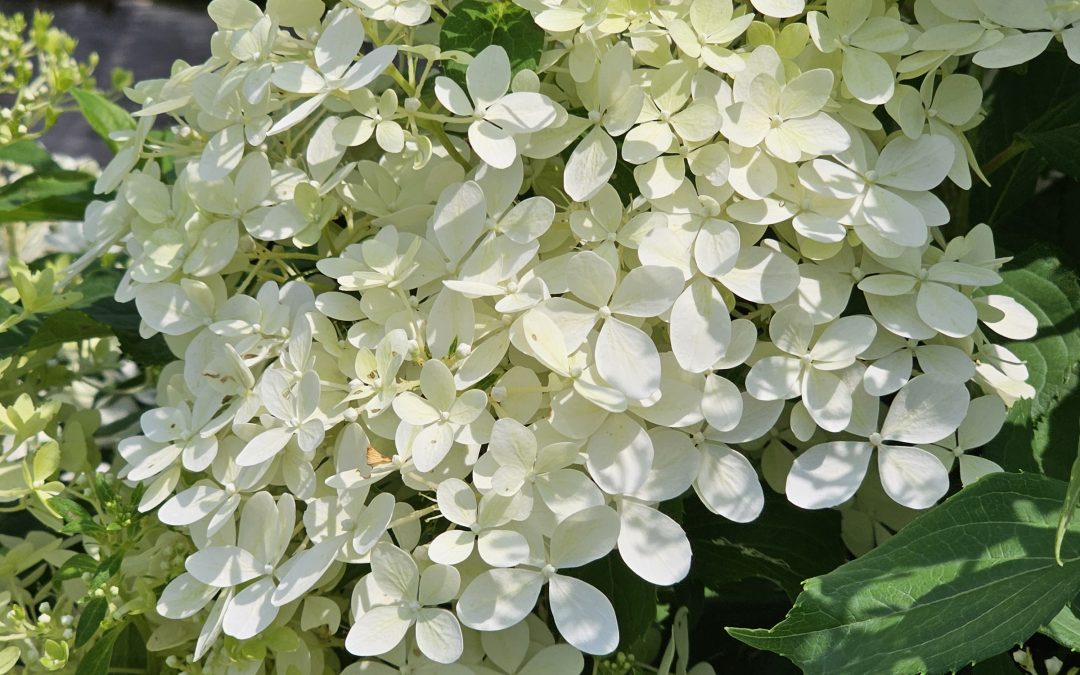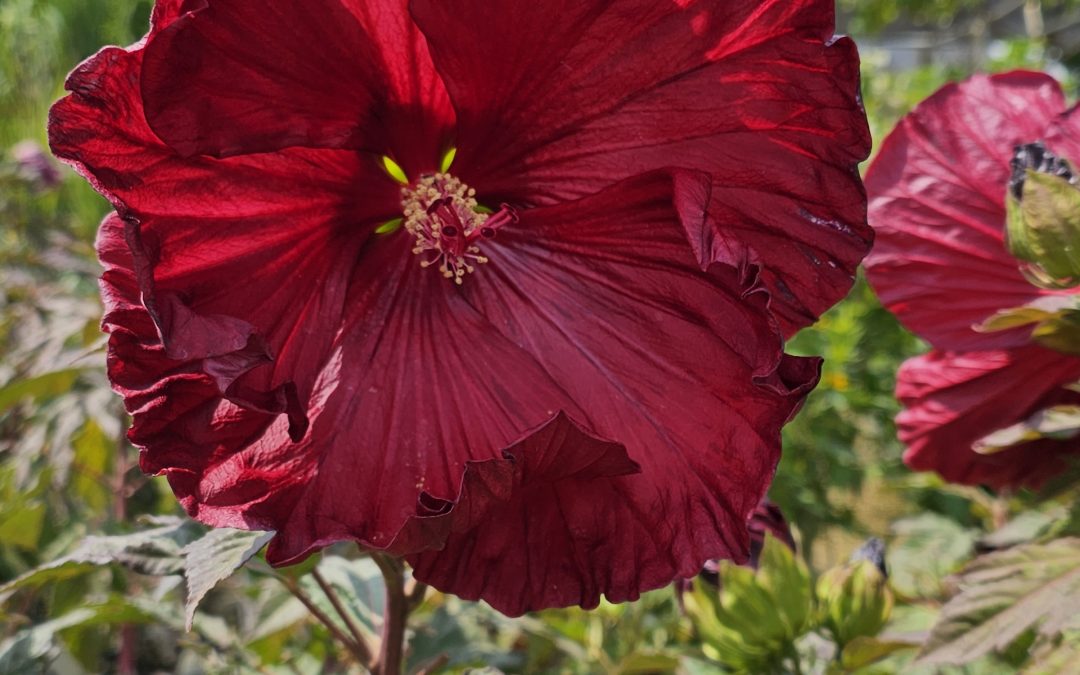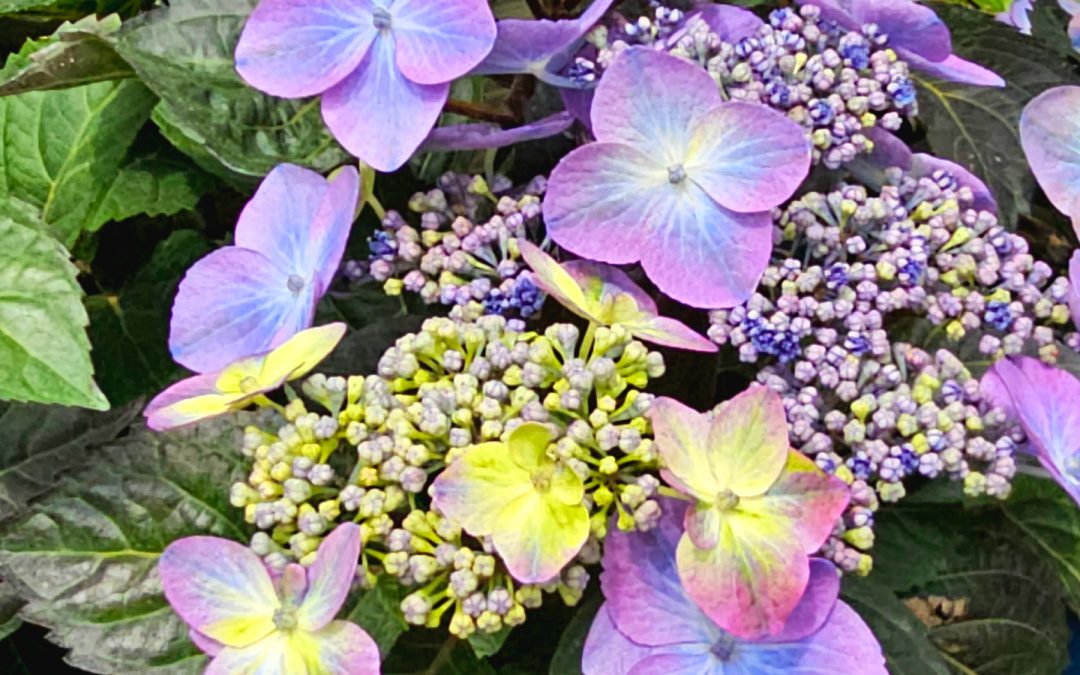
Think of the Puffer Fish hydrangea as a bigger, more puffed up version of the Bobo hydrangea, with fluffy white blooms that adorn the plant from early summer through early fall. When planted in an area that receives at least 6+ hours of sun daily, this hydrangea can grown to be about 3-5‘ h x 3-5‘ w. Although the Puffer Fish can adapt to most soil types, it prefers a good loamy soil and adequate watering. If cut and/or dried flowers are your thing, then this beauty won’t disappoint. Not much of a gardner? No worries as this shrub requires little maintenance. Each spring ammending the 1st layer of soil around the shrub with a good quality fertilzer like Bio-tone or Plant Tone (that can be obtained at our nursery) followed by a fresh layer of mulch, will ensure a good seasonal start.

In need of an eye-catching perennial in your planting beds that will sure draw attention? The large deep red color of the Summerific Cranberry Crush hibiscus flowers will do just that. When planting, be sure to give this beauty room to grow as this upright tops off around 4’ h x 4-5’ w. When given part sun-full sun daily, along with moist well-draining soil, the easy growing hibiscus will maintain the focal point from mid-summer until early fall. If adding one of these plants to your landscape it is advisable to have in the ground well before the heat of summer arrives and plan on heavily mulching for the first winter. In the spring, you can cut back stems to 4-6” tall but do so before new growth appears. Hibiscus plants are usually late to emerge, so don’t panic if no new leaves appear when the rest of your perennials are well on their way.

Truly a unique variety of Rose of Sharon is the Purple Pillar. Unlike other Rose of Sharon plants, this one naturally grows as a narrow column instead of a wide, spreading plant. With heights topping off between 12-16′ and widths around 4′ building a privacy screen or hedge becomes effortless. Don’t need a hedge? This stunning specimen can be used as a stand-a-lone, focal point in a planting bed or in large patio pots. Along with dark green foliage, in summer each stem will be packed with beautiful long lasting semi-double purple flowers that will bloom until fall.
The Purple Pillar attracts bees, hummingbirds, and butterflies, but resists deer, and drought and is heat tolerant. Like most all hibiscus, it will do best in full sun and needs good drainage. Requiring minimal maintenance, providing several planting options, along with a healthy dose of color, a Purple Pillar would be a great addition to any landscape.

Wanting to make a big, colorful impact to your landscape, the Pop Star Hydrangea does just that. This season-long reblooming flower power with its large lacecap blooms not only brings unique texture, it will also attract bees, butterflies, and other garden pollinators. Growing to a height and width of only 18 to 36 inches tall and wide the tight compact shrub makes an ideal choice for planting beds or containers.
This plant will truly shine if planted in areas receiving sun/part shade. Although naturally disease resistant, regular pruning will help maintain overall appearance as well as the addition of soil acidifier to enhance the natural PH for more vivid color.

Have a pergola, trellis, retaining wall or fence line in full sun that is need of some color? Why not try an Aunt Dee Wisteria vine. Being one of the hardiest of all wisterias, this vine features coppery-bronze foliage that will turn green and later, yellow. Stunning chains of fragrant lilac-purple flowers cascade from the stems in the spring attracting hummingbirds and butterflies.
Deer are not fans, so this is one plant that they will leave alone. Although breathtaking, wisterias are not for the inexperienced gardener as they will require much-needed care. The vigorous growing twining vine can grow to be about 30′ tall and 24′ wide. With that said, it should be trained to grow upwards or trail sideways. Aunt Dee Wisteria will become quite woody, so ample support will be needed along with regular pruning in order to maintain the health and beauty of this plant.
As with other vines, the base tends to look a bit leggy and bare so planting some sun-loving perennials in front will provide the right amount of camouflage and remedy that situation. Pet owners and people with children will need to exercise caution if choosing this plant as it can be toxic if eaten.





